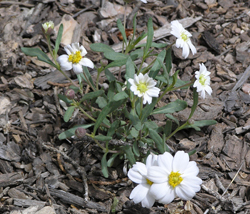
Bee-Coming
Rarer
(silk hanging)
Honeybees
—Bunny Bowen
When I was eleven, I chose to study the honeybee for my first Science Fair project. As I was more of an artist than a scientist, my project ended up being more of a report than an experiment. I carved an eight-inch long worker honeybee out of balsa wood, with eisenglass wings... I think maybe I carved the legs from balsa too.
By age twenty-four I was carving and building wax models for cast silver jewelry. We also used various wax mixtures for injection into rubber molds in the lost wax casting technique.
At thirty-five I learned still another use for beeswax: batik, the medium which has occupied my creative energies ever since. Typically I've purchased beeswax from bee keepers, who sell it in varying levels of purity. To prepare it for batik I usually had to heat it in frypans in the yard and strain it through nylon mesh stretched over embroidery hoops. This removed most of the bee body parts, the honey, and dirt.
After nearly four decades of depending upon bees for my artwork, I welcomed the opportunity to actually watch a beekeeper take apart and check his top bar hive. He made sure I was fitted with gloves, mesh netting over a wide brimmed hat, and a light colored shirt. He had a smoker going as he carefully removed the top cover to reveal the horizontal wooden bars upon which the bees build the comb.
One by one, the bars were gently lifted and inspected. The comb was built down from the bars, and was covered with workers steadily going about their jobs. Some bees flew in laden with yellow pollen, while others had found dark red-orange pollen. The domed cells held drones, while the cells with flat covers held workers. A few bees danced, conveying information about where they had found flowers, while guard bees warned us to stay away.
Throughout the whole procedure, nobody got stung. Pretty amazing, since each bar was taken out and held up in the daylight. We never spotted the queen, though it was obvious that she was laying eggs and the colony was healthy.
 When I realized how many bees it must take to make a spoonful of honey or a pound of wax, I decided to take extra care with the flowers I plant... no insecticides ever, and choosing plants that are good pollen-producers. When I realized how many bees it must take to make a spoonful of honey or a pound of wax, I decided to take extra care with the flowers I plant... no insecticides ever, and choosing plants that are good pollen-producers.
After all, they've given me a lifetime of fruit and veggies thanks to being pollinators, as well as honey. And they've provided many pounds of wax for my batik.
It's the least one can do. |
